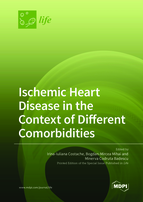Ischemic Heart Disease in the Context of Different Comorbidities
A special issue of Life (ISSN 2075-1729). This special issue belongs to the section "Medical Research".
Deadline for manuscript submissions: closed (16 June 2022) | Viewed by 40332
Special Issue Editors
Interests: ischemic heart disease; arterial hypertension; pulmonary embolism; heart failure; biomarkers
Special Issues, Collections and Topics in MDPI journals
Interests: diabetes; metabolic diseases; cardiology; diabetic kidney disease
Special Issues, Collections and Topics in MDPI journals
Interests: cardiovascular disease; atherosclerosis; arterial thrombosis; venous thrombosis; anticoagulants; hereditary thrombophilia; inflammation
Special Issues, Collections and Topics in MDPI journals
Special Issue Information
Dear Colleagues,
The field of cardiology is very dynamic and is constantly evolving and improving. Our knowledge about myocardial ischemia is deepening every day, as major progress is made both in understanding its pathophysiological substrate and in improving diagnostic algorithms and therapeutic protocols.
Myocardial ischemia is the fundamental substrate of acute and chronic coronary syndromes. Beyond this major role, its importance resides in its coexistence with many pathological conditions in which myocardial ischemia appear either as an associated factor or as a consequence.
Firstly, the diagnosis of myocardial ischemia in the context of non-cardiac comorbidities can be a challenge for the clinician, who has the difficult task of choosing appropriate paraclinical investigations from many options—ECG, biomarkers, stress test, invasive and non-invasive imaging procedures—to establish a correct diagnosis.
Secondly, the high incidence and severe prognosis of myocardial ischemia highlight the need for continuous research in the field to optimize diagnosis and treatment and to improve the prognosis and survival of patients.
Thirdly, atherosclerotic disease as a whole and myocardial ischemia in particular are frequently associated with a complex metabolic background. Innovative therapies bring important benefits, providing protection against atherosclerotic disease and significantly reducing major adverse cardiovascular events in dedicated clinical trials.
To summarize, these are the main reasons why we chose this broad topic. Our goal is to form a team of specialists whose advanced experience allows us to understand the complex mechanisms of the bidirectional relationship between myocardial ischemia and various pathologies. Therefore, we invite you to share your knowledge and experience and thus help to identify the best diagnostic and therapeutic solutions for our patients.
Prof. Dr. Irina-Iuliana Costache
Prof. Dr. Bogdan-Mircea Mihai
Dr. Minerva Codruta Badescu
Guest Editors
Manuscript Submission Information
Manuscripts should be submitted online at www.mdpi.com by registering and logging in to this website. Once you are registered, click here to go to the submission form. Manuscripts can be submitted until the deadline. All submissions that pass pre-check are peer-reviewed. Accepted papers will be published continuously in the journal (as soon as accepted) and will be listed together on the special issue website. Research articles, review articles as well as short communications are invited. For planned papers, a title and short abstract (about 100 words) can be sent to the Editorial Office for announcement on this website.
Submitted manuscripts should not have been published previously, nor be under consideration for publication elsewhere (except conference proceedings papers). All manuscripts are thoroughly refereed through a single-blind peer-review process. A guide for authors and other relevant information for submission of manuscripts is available on the Instructions for Authors page. Life is an international peer-reviewed open access monthly journal published by MDPI.
Please visit the Instructions for Authors page before submitting a manuscript. The Article Processing Charge (APC) for publication in this open access journal is 2600 CHF (Swiss Francs). Submitted papers should be well formatted and use good English. Authors may use MDPI's English editing service prior to publication or during author revisions.
Keywords
- myocardial ischemia
- acute coronary syndrome
- chronic coronary syndrome
- atherothrombosis
- biomarkers
- coronary imaging
- revascularization
- prevention









